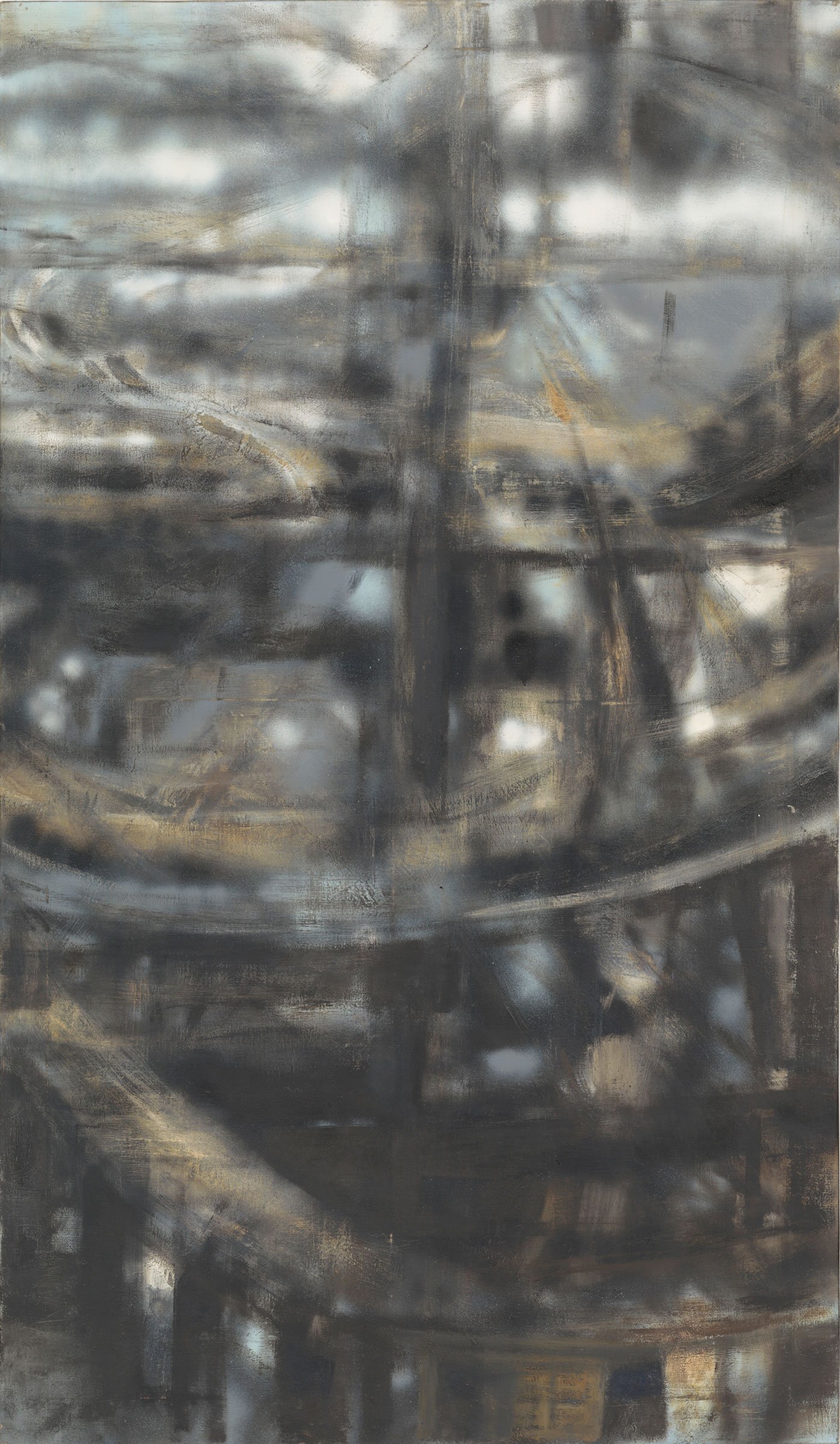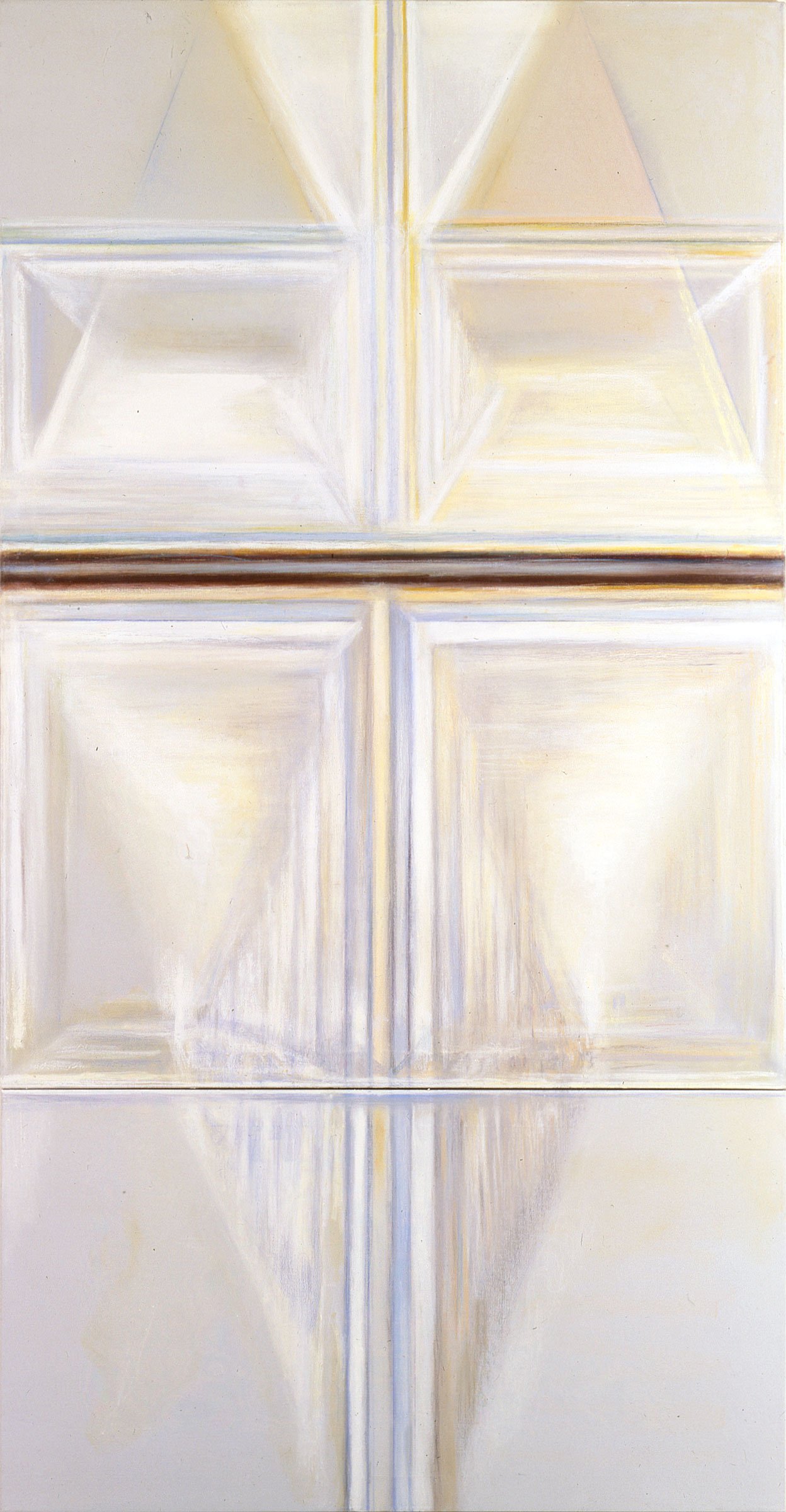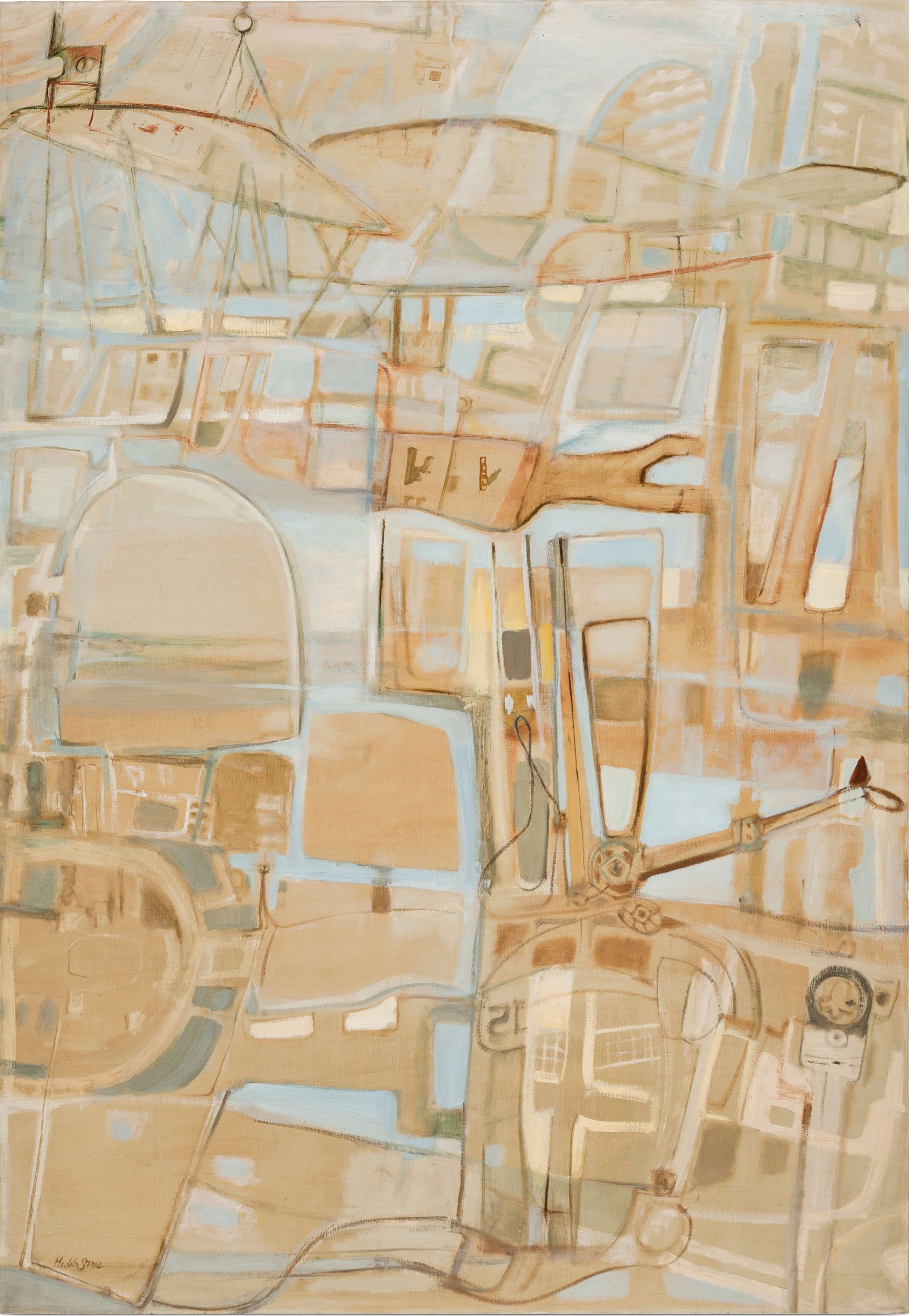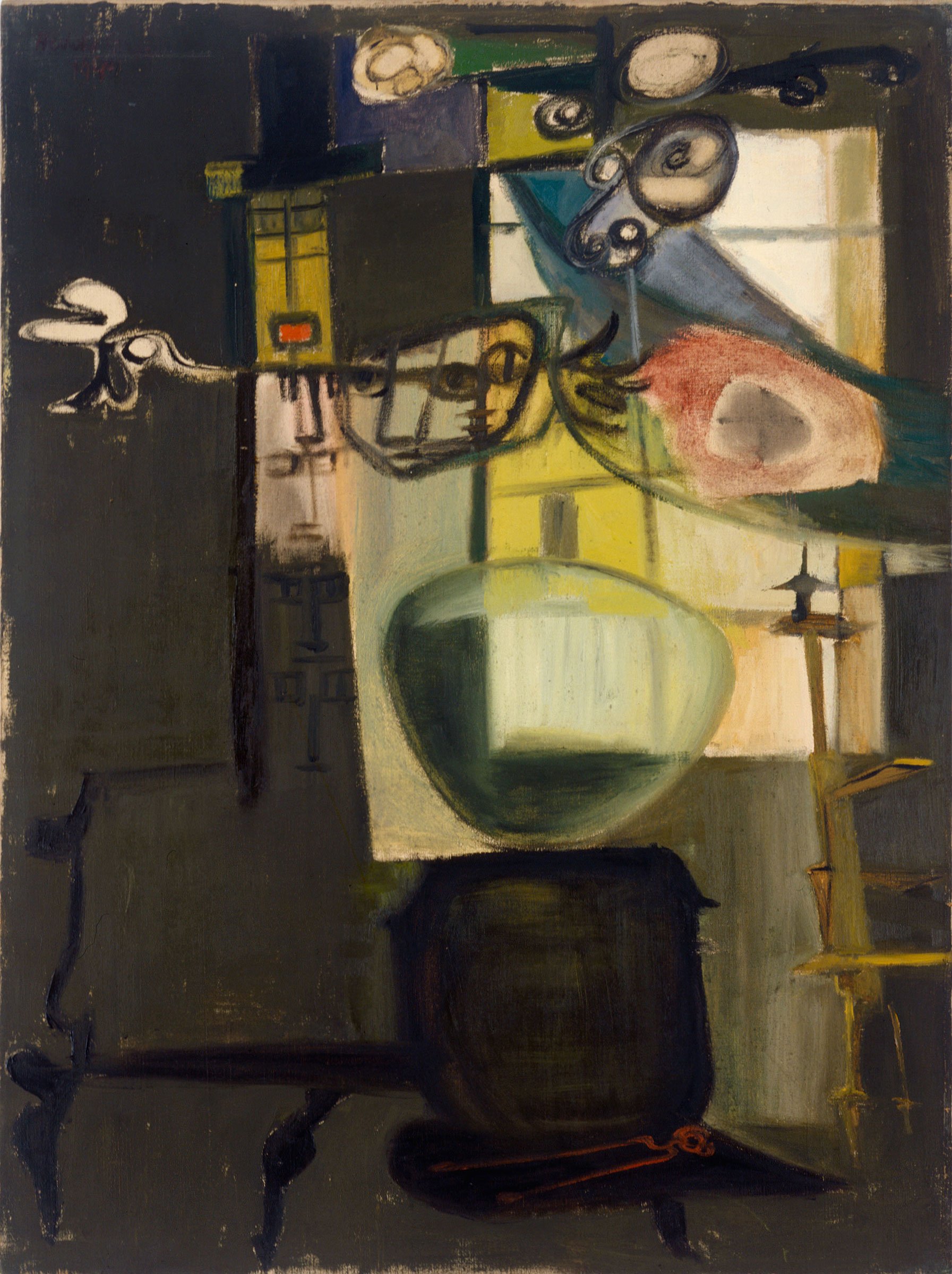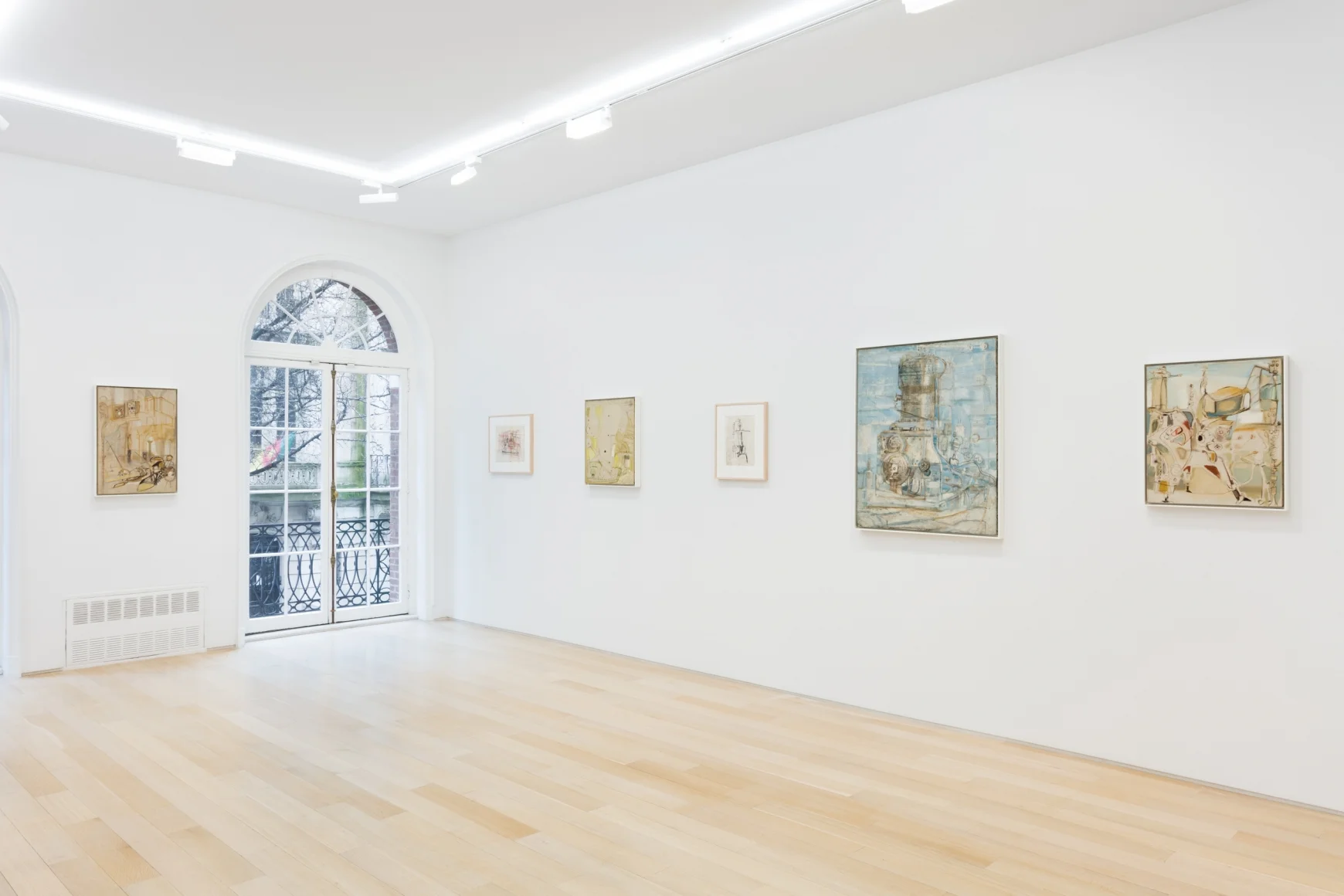The Artist
Hedda Sterne in 1943 with her painting, around the time of her first solo exhibition in the US
“I see myself as a well-working lens, a perceiver of something that exists independently of me: don’t look at me, look at what I’ve found.”
Hedda Sterne was a prolific artist whose long career intersected with some of the most important movements and figures of twentieth-century art. Sterne described her extensive body of work, exhibited early on with the Surrealists and later with the Abstract Expressionists, as a process of exploration and discovery. Her work, she felt, could be seen as a visual diary of her experiences and philosophies as they evolved over time.
Sterne’s legacy is a rich and multilayered contribution to the history of twentieth-century art, at once the record of a personal journey, and the reflection of a progressive approach to art-making that places the artist ahead of her time.
A Brief Biography
Hedda Sterne was born Hedwig Lindenberg in Bucharest, Romania, in 1910, the second child of Eugenie and Simon Lindenberg. Simon was a language teacher and taught Hedda and her brother, Edouard, to be fluent in French, German, and English from a young age. Musical education was also prioritized (Edouard would become an accomplished conductor and musician); however, Hedda insisted that she be given art lessons instead.
“One day my father came home with an easel and paper and told me I can study art. Well, this was and is to this day the happiest moment of my life. I was deliriously happy.”
Sterne began studying art in the studio of the respected classical sculptor Frederic Storck. Around the same time in Zürich, Romanians Tristan Tzara and Marcel Janco were gaining notoriety for their roles in the rising Dada movement. For years, Bucharest had been home to a thriving modernist tradition, seeding the European avant-garde through a growing cultural exchange. And while Sterne took well to her formal studies, she was galvanized by the city’s frenetic avant-garde scene. As a teenager, she attended Constructivist exhibitions and read radical modernist magazines. Central players in the movement became her friends and mentors, including M. H. Maxy and Victor Brauner. By age sixteen, Sterne was working in the atelier of Marcel Janco, newly returned from Zürich.
After graduating high school in 1928, Sterne continued her art education abroad. She studied ceramics at the Vienna Kunstgewerbeschule (School of Arts and Crafts), in Paris at Académie de la Grande Chaumière, and in the ateliers of Fernand Léger and André Lhote. The following year she enrolled in the University of Bucharest, where she studied philosophy and art history.
“The greatest influence in my life when I was young was surrealism, without a doubt.”
In 1932, Hedda Lindenberg married Frederick “Fritz” Stern, whom she had met when she was sixteen and he was a university student. They shared an intellectual curiosity, and a love of art and travel. Fritz encouraged and supported Hedda’s art practice. She had been deeply influenced by the surrealist movement since the mid-1920s, following its development through manifestos and modernist magazines. In the 1930s, she kept abreast of the movement through frequent visits to Paris. Her stays would often overlap with those of her friend and mentor, Victor Brauner, who became an advocate of her work within the surrealist circles in Paris.
Sterne’s first solo exhibition was held in Bucharest in 1936. Soon after, she had her first opportunity to exhibit within the surrealist context in two group shows in Paris: the 1938 Salon des Surindépendants and the 1939 Salon des Indépendants. Through Brauner and Jean Arp, her collages were recommended to Peggy Guggenheim for a group exhibition at her gallery in London. But with the outbreak of World War II, Sterne left Paris and returned to Romania.
By the end of the 1930s it had become clear to Hedda and Fritz that their marriage was not working. They separated amicably, and when Fritz left Europe for the US in the spring of 1940, Hedda remained behind in Bucharest. It was a tumultuous time. By the end of the year, Romania had sided with the Axis forces. In January 1941, a political rebellion led to the infamous Bucharest pogrom; Sterne narrowly escaped that night’s roundup and slaughter of Jews in her neighborhood. In the US, Fritz began petitioning to have his family, including his estranged wife, admitted to the country. She spent months collecting all the necessary visas to eventually flee Romania in October 1941.
“When I came to the United States, I was struck that this country was more surrealistic than anything anybody imagined.”
Sterne arrived in New York City on October 27, 1941. She was met by her estranged husband, who helped her to settle into a radically new environment. She established a studio and apartment on East 50th Street near Beekman Place. Soon after, she found herself welcomed by her neighbor Peggy Guggenheim and ushered into one of the world’s historic gatherings, the “surrealists in exile.”
Sterne described her first years in the US during World War II as an experience “so extraordinary, so bizarre, so absorbing”—she likened it to being on the moon. Many of the artists and writers she had admired in Europe were now friends and acquaintances: the quiet man who sat beside her at a party was Piet Mondrian; Max Ernst and Peggy Guggenheim were close friends; she formed a deep friendship with Antoine de Saint-Exupéry—he would call her in the middle of the night to read her passages of his work in progress, Le Petit Prince.
Amid all the tumult of her new life in New York during the war, Sterne’s artistic career also began to evolve. André Breton and Marcel Duchamp included her work in the pioneering exhibition “First Papers of Surrealism,” in 1942. She was in multiple group exhibitions at Peggy Guggenheim’s Art of This Century gallery, including the influential shows “31 Women” and “The Women.” In 1943, she had her first solo exhibition in the US, organized by Betty Parsons at the Wakefield Gallery. The show was favorably reviewed by ArtNews, The New York Times, and Herald Tribune. This began two decades of regular exhibitions, making Sterne among the most frequently exhibited female painters of her generation.
“In my generation art was seen as a great act of freedom and independence—that was the only thing that united this group.”
Sterne’s striking presence in the famous photograph known as The Irascibles is a reflection of her active part in the community that would later be known as the New York school—though she was quick to point out that the artists present in the photograph did not intend to represent a new art movement.
Sterne had chosen to remain in the US after the war, while many of her European compatriots returned, as did Peggy Guggenheim. The Betty Parsons Gallery opened in 1946 with Sterne listed as the only female painter represented alongside Mark Rothko, Clifford Still, Barnett Newman, and, soon, Jackson Pollock. Her work was often exhibited alongside these men, and in annual solo exhibitions at the gallery. In 1950, when a group of artists gathered for a symposium, she was one of three women in attendance (also present were Louise Bourgeois and Janice Biala). A letter of protest drafted after the meeting, and signed by many in attendance, led to the press coverage and the photograph. Fifteen of the more than twenty-five artists at the symposium are present in the photograph, published in LIFE magazine in January 1951.
The photograph is a rare group image that includes some of today’s most well-known figures of American abstraction. Sterne’s presence as the only woman drew considerable attention from the very start. She was asked often enough about the photograph that she would later express bewilderment: she would tell an interviewer, “I am known more for that darn photo than for eighty years of work. If I had an ego, it would bother me.”
“He came to lunch and stayed. It was like that. After half an hour we had the feeling we had known each other all our lives.”
Hedda Sterne met Saul Steinberg in February 1943. They were both Jewish Romanian refugees newly arrived in New York. Like Sterne, Steinberg had narrowly managed to escape Fascist Europe at the outbreak of World War II. They found an instant connection at their first meeting, leading to marriage and lifelong friendship. After the war (during which Steinberg served abroad as a US Navy ensign), their home “formed the center of a culture all its own at the heart of the intellectual establishment,” including artists, writers, and New Yorker contributors.
Both Sterne and Steinberg brought to their art a sense of wonderment inspired by their adopted homeland. In a joint profile in LIFE magazine, published in August 1951, the pair are described as “both fascinated by the US; he by the habits of people; she by machines and towering structures. Both want to create a new picture of America, but not the same pictures.” They traveled often: to Europe after the war to see friends, family, and familiar places; and around North America to experience new environments and landscapes.
Sterne and Steinberg began living apart in 1960—they would lead separate lives, but never divorce. Indeed, until Steinberg’s death in 1999, they spoke on the phone daily and remained close friends and confidants.
“For such a long time now, painting and drawing for me have ceased to be a matter of making, but rather a way of functioning.”
In 1960, after her separation from Steinberg, Sterne began a new pace of living. For the second half of her life, she would dedicate herself fully to her art, reading, and writing. The art world in New York was changing quickly for artists of her generation. She chose to exhibit less and, in her words, “reduce the ego.” She began meditating daily in the mid-1960s, a practice that would have a deep impact on her life and work.
After spending much of the early 1960s living in Venice and Paris, Sterne returned to the US and purchased a home in East Hampton. She spent the next several decades switching between her residences in Manhattan and on Long Island. She kept a close and tight-knit group of friends, and worked in her studios for hours every day. She was incredibly prolific. She would say, “I never thought in terms of a career, but I worked with tremendous urgency…there were times when I thought I had inhibitions about being professional, but in the end I'm glad I was like that.”
When Sterne passed away at the age of 100 in 2011, she had been leading a mostly private and quiet life for nearly half a century. She had established The Hedda Sterne Foundation and endowed it with her personal collection of art, archives, and library. What she has left behind is an astonishing record of the life of an extraordinary artist. Sterne was a product of the European avant-garde, whose contribution to the rise of American abstraction is yet to be fully comprehended, and whose independence reflects the core role artists play in our society today.
Artwork
“For me, my painting life has been a diary. I’ve functioned almost like a movie camera, moving through the years from immediate nearness to medium distance to far and remote vistas and then back again.”
Hedda Sterne’s artworks are represented in the collections of The Art Institute of Chicago, Carnegie Museum of Art, Pittsburgh, the National Gallery of Art, Washington, D.C., The Metropolitan Museum of Art, Whitney Museum of American Art, the Museum of Modern Art, New York and The Tate Modern, London.
Retrospective exhibitions have been mounted at the Montclair Art Museum, New Jersey in 1977, Queens Museum, New York, in 1985, and Uninterrupted Flux: Hedda Sterne, A Retrospective at the Krannert Art Museum, University of Illinois at Urbana-Champaign in 2006.
View Exhibitions >

